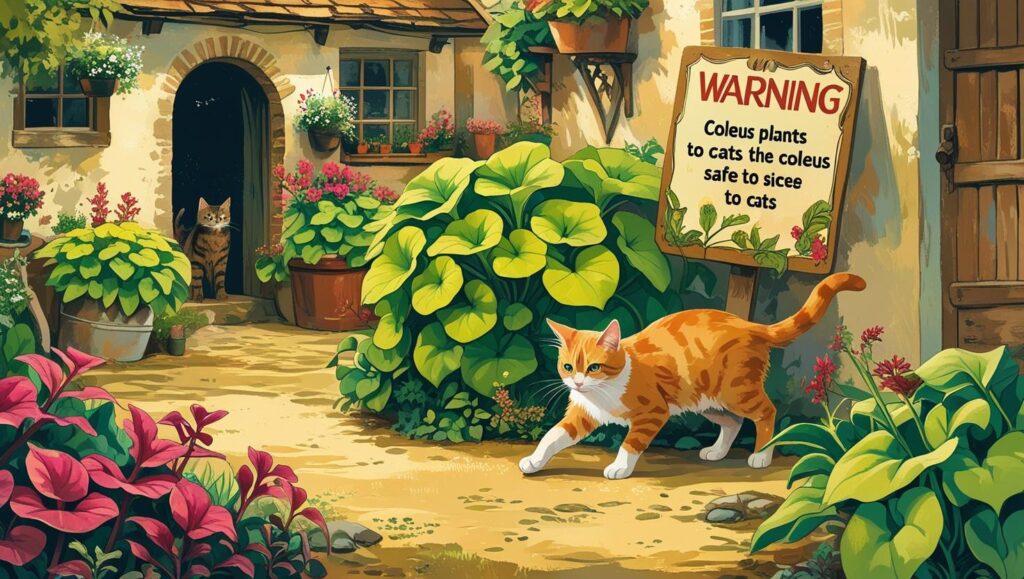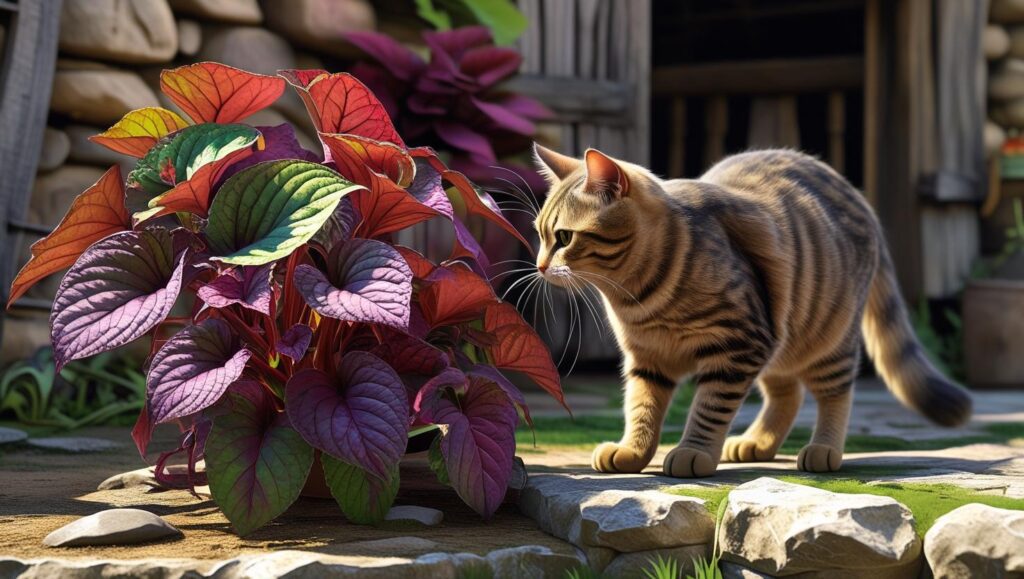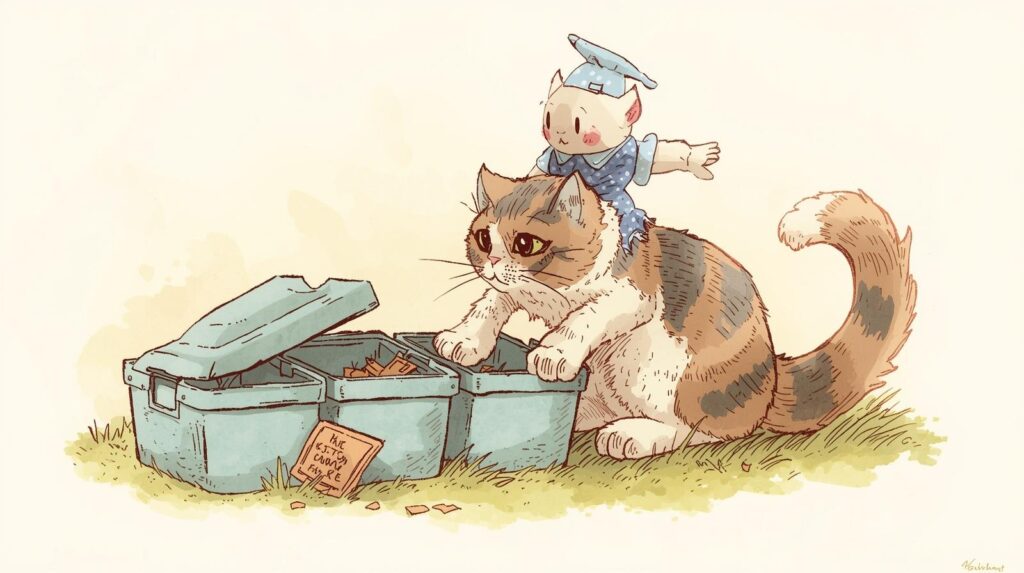
Cats are naturally curious creatures. If you’re a pet parent, you’ve probably seen your furry friend nibbling on leaves or sniffing around houseplants. While this behavior may look innocent, some plants can actually pose serious health risks. One common question cat owners ask is: Is Coleus Toxic to Cats?
The short answer is yes — Coleus plants can be toxic to cats if ingested. But don’t panic just yet. In this blog, we’ll uncover 7 essential facts you need to know about Coleus toxicity, the dangers it poses, how to recognise symptoms, and safer plant alternatives you can keep at home.
Let’s dive in.
Table of Contents
What is the Most Toxic Plant to a Cat?
When cat owners ask, “What is the most toxic plant to a cat?”, they are usually looking for a clear list of dangerous plants, early symptoms to watch for, and steps to keep cats safe indoors and outdoors. Cats are naturally curious and love to chew on leaves, but unfortunately, many common household and garden plants are highly toxic to them.
Most Dangerous Plant for Cats: Lilies
According to veterinarians and the ASPCA, true lilies (Lilium and Hemerocallis species, like Easter Lily, Tiger Lily, Day Lily) are considered the most toxic plants for cats. Even a tiny amount of pollen, a leaf, or drinking water from the vase can cause sudden kidney failure. Unlike some plants that only cause mild stomach upset, lilies are life-threatening within hours if untreated.
Symptoms of Lily Poisoning in Cats:
- Vomiting within 2–4 hours
- Drooling and loss of appetite
- Increased thirst but little to no urination (sign of kidney damage)
- Lethargy, hiding, or seeming “out of it”
- If you suspect your cat has eaten any part of a lily, treat it as an emergency and contact your vet immediately.
Other Highly Toxic Plants to Cats
While lilies top the danger list, pet parents should also be aware of these other plants cats often encounter:
- Sago Palm – Causes liver failure; even one seed is deadly.
- Oleander – Affects the heart; can cause arrhythmias and sudden death.
- Azaleas & Rhododendrons – Lead to severe vomiting, drooling, and heart issues.
- Tulips & Hyacinths – Bulbs are especially toxic, causing drooling, diarrhoea, and tremors.
- Coleus – While not always fatal, it can irritate the stomach, cause vomiting, and in some cases, affect the central nervous system.
This is why cat owners often search “Toxic and Non-Toxic Plants: Coleus” to know if this decorative plant is safe. We’ll cover that in more detail below, but for now, remember that even “mildly toxic” plants can be risky if your cat chews them regularly.
Pro Tip: If you love plants, choose cat-safe varieties like spider plants, Boston ferns, or cat grass. They add greenery without putting your pet’s health at risk.
Do Cats Dislike Coleus Plants?

Cat owners often wonder if cats naturally stay away from Coleus plants or if they might chew on them out of curiosity. The truth is, cats don’t all react the same way. Some cats completely ignore Coleus, while others are drawn to the plant’s colourful leaves or strong, minty smell.
Unlike catnip, which contains nepetalactone (a compound that excites most cats), Coleus doesn’t usually have an appealing effect. In fact, some varieties of Coleus canina are marketed as “scaredy-cat plants” because their odor is said to repel cats and dogs. However, many owners report that the smell is only mildly unpleasant and doesn’t always stop curious cats from chewing the leaves.
Why Some Cats Still Chew Coleus
Even if cats don’t “like” the plant, chewing on Coleus may happen because of:
- Curiosity – Cats explore new textures with their mouths.
- Boredom – Indoor cats sometimes chew plants when they lack stimulation.
- Hunting Instincts – The moving leaves may trigger playful biting.
- Digestive Relief – Some cats chew greenery to help with hairballs.
So while Coleus isn’t typically a plant that attracts cats, it’s not a guarantee that your cat will avoid it.
Practical Advice for Cat Owners
- Don’t assume Coleus will naturally repel cats. Some cats may still chew it.
- If your cat shows interest, it’s safer to remove the plant because Coleus contains essential oils and compounds that may cause vomiting, drooling, or diarrhoea.
- For a natural deterrent, consider cat-safe plants like cat grass, valerian, or silvervine to redirect chewing behavior.
Pro Tip: If your main goal is to keep cats out of your garden, Coleus canina may help, but it works better when combined with other cat-deterring methods like citrus peels, coffee grounds, or motion-sensor water sprayers.
Is Coleus Canina the “Scaredy Cat Plant”?
Coleus canina, often sold under the nickname “Scaredy Cat Plant,” is a special variety of Coleus that gardeners claim can repel cats and dogs with its strong odor. The plant releases a skunk-like or musky smell when touched or brushed against. Because of this reputation, many people buy it hoping it will keep curious cats away from flower beds or gardens.
But does it really work? The answer is: sometimes, but not always.
Does It Really Repel Cats?
- Mixed Results – Some gardeners report success, saying neighbourhood cats avoid areas where Coleus canina is planted. Others claim their cats walk right past it without caring.
- The Smell Factor – The strong odor is the main deterrent, but it only works if cats come close enough to smell or touch it. Wind, weather, and plant placement can reduce its effect.
- Not a Guaranteed Solution – If you’re relying solely on Coleus canina, you may be disappointed. Pairing it with other deterrents like motion-activated sprinklers, citrus scents, or chicken wire fencing gives better results.
Is Coleus Canina Safe for Cats?
Even though it’s marketed as a “cat-repelling” plant, it’s important to know:
- Coleus canina, like other Coleus varieties, may cause mild stomach upset (vomiting, drooling, or diarrhoea) if a cat chews the leaves.
- It’s not usually deadly, but it’s still best to keep it out of reach if your cat is a plant chewer.
- For indoor safety, opt for cat-friendly plants like catnip, cat thyme, or wheatgrass instead.
Will Animals Eat Coleus?
Many pet parents and gardeners worry not just about cats but also about dogs, rabbits, and even wild animals nibbling on their plants. Since Coleus is colorful and soft-leaved, it can be tempting for curious animals. But should you be concerned if your pets chew on it?
Many pet parents and gardeners worry not just about cats but also about dogs, rabbits, and even wild animals nibbling on their plants. Since Coleus is colorful and soft-leaved, it can be tempting for curious animals. But should you be concerned if your pets chew on it?
Cats and Dogs
- Cats – Some cats may chew Coleus leaves out of curiosity or boredom. Unfortunately, this can cause vomiting, drooling, diarrhea, and stomach upset. Cats who don’t have enough safe chewing options (like cat grass) may be more tempted.
- Dogs – Puppies and small dogs are more likely to bite leaves during play. While Coleus is usually not deadly, it may cause gastrointestinal upset, depression, or loss of appetite in dogs.
Tip: If your cat is chewing plants, it might be a sign they’re bored or stressed. Providing a clean and inviting litter box area, plus cat grass or toys, can redirect their chewing behaviour.
Rabbits and Other Animals
- Rabbits – Rabbits are plant nibblers by nature. They can chew Coleus, but it’s not recommended since it may upset their digestion.
- Deer & Wildlife – Gardeners often report that deer avoid Coleus because of its strong smell, making it less likely to be eaten outdoors.
What To Do If Your Pet Eats Coleus
- Remove any leftover plant pieces from their mouth.
- Offer water to flush out the taste.
- Watch for symptoms like vomiting, drooling, or diarrhea.
- Call your vet if symptoms persist, especially for small kittens, puppies, or senior pets.
What Happens if My Cat Eats Coleus?

If your cat has nibbled on a Coleus leaf, you’re probably worried and searching for answers. The good news: Coleus is not usually fatal to cats, but it can cause uncomfortable symptoms that may need attention.
Common Symptoms in Cats
If your cat eats Coleus, you may notice:
- Drooling or pawing at the mouth
- Vomiting (sometimes near or inside their cat litter area)
- Diarrhoea and stomach cramps
- Loss of appetite for a day or two
- Lethargy or low energy
These symptoms usually appear within a few hours of chewing the plant.
Why Coleus Affects Cats
Coleus contains essential oils and compounds that irritate a cat’s digestive system. Even a few bites can upset a sensitive stomach. Indoor cats, especially, may chew plants out of boredom or curiosity, not hunger.
What To Do if Your Cat Eats Coleus
- Remove plant pieces from your cat’s mouth if visible.
- Offer fresh water to help dilute toxins.
- Check the cat litter box for changes in stool or urine, which can show how badly the stomach is reacting.
- Monitor for severe symptoms such as repeated vomiting, blood in stool, or extreme weakness.
- Call your vet if symptoms last longer than 24 hours or worsen quickly.
Will My Cat Recover?
Most cats recover in a day or two once the plant leaves their system. Keeping your cat hydrated, comfortable, and away from Coleus plants ensures a smooth recovery. However, kittens, elderly cats, or cats with weak immune systems may need immediate vet care.
What Plants Scare Cats Away?
Many cat owners and gardeners search for “plants that deter cats naturally” or “plants safe to repel cats”. While Coleus Canina is famously called the “Scaredy Cat Plant”, there are other plants that naturally keep curious felines at a distance.
Cat-Repelling Plants (Safe Options)
Here are some plants that cats usually dislike due to their smell or taste:
- Coleus Canina (Scaredy Cat Plant): Emits a skunk-like odor when touched.
- Lavender: Cats dislike its strong scent, though it should be used with caution since lavender can cause mild stomach upset if eaten.
- Rosemary: Strong aroma that keeps cats away but safe when grown outdoors.
- Lemon Balm: Cats don’t like its citrusy smell.
- Rue: Known for repelling cats, but must be placed where pets can’t chew it since ingestion can be harmful.
- Curry Plant: Strong, pungent smell that cats avoid.
Indoor vs. Outdoor Use
- Indoors: Use mild deterrent plants like rosemary or lemon balm in pots.
- Outdoors: Scaredy Cat Plant or curry plant works well along garden borders to discourage strays.
Bonus: Smells That Cats Avoid
Apart from plants, cats dislike scents such as citrus peels, coffee grounds, vinegar, and peppermint. Some gardeners sprinkle these around flower beds to stop cats from digging.
Important Note on Safety
While some plants repel cats, not all are safe if chewed. Always research plant toxicity before placing them near your pets. If you want a cat-friendly repellent, choose herbs and flowers that cats dislike but that won’t harm them if they take a nibble.
What Plants Cats Won’t Destroy?
One of the most common struggles cat owners face is finding plants that survive curious paws and teeth. Readers often search:
- “Cat safe indoor plants that won’t get eaten”
- “Pet-friendly plants cats won’t chew”
- “Best hardy plants for homes with cats”
- “Which plants are safe AND unattractive to cats?”
This shows that people don’t just want safe plants — they want durable greenery that cats tend to avoid.
Cat-Proof Plants That Survive Indoor Living
Here are some plants that most cats usually ignore or dislike, while being safe if accidentally nibbled:
- Spider Plant (Chlorophytum comosum): Hardy, resilient, and safe, though some cats may play with its long leaves.
- Areca Palm (Dypsis lutescens): Elegant and non-toxic, usually left alone by cats.
- Calathea (Prayer Plant): Attractive foliage, safe for cats, and not as tempting to chew.
- Bamboo Palm: A tough indoor plant that thrives with little attention and is cat-friendly.
- Cast-Iron Plant (Aspidistra): Known for being nearly indestructible — perfect for households with playful cats.
Plants Cats Tend to Avoid
Cats often dislike plants with thick, waxy leaves or strong scents. Examples:
- Succulents (Non-toxic types like Haworthia or Echeveria): Cats rarely chew these.
- Rosemary: Cats dislike its sharp smell.
- Lemon Balm: Safe and citrusy — cats don’t enjoy it.
Tips to Protect Your Plants From Cats
Even safe plants can get tipped over or scratched. Here’s what many readers actually want to know:
- Place plants higher up: Use shelves, plant stands, or hanging baskets.
- Use natural deterrents: Citrus peels or coffee grounds around pots discourage chewing.
- Provide alternatives: A pot of cat grass gives your cat a safe plant to chew on, reducing interest in your decor.
- Use sturdy pots: Heavy pots prevent cats from knocking plants over during play.
FAQs:
Coleus toxic to cats symptoms?
The common symptoms include vomiting, diarrhea, drooling, reduced appetite, and lethargy. In some cases, cats may also develop mild skin irritation.
Is Coleus toxic to dogs?
Yes, Coleus is also toxic to dogs. Symptoms include drooling, diarrhea, vomiting, and general stomach upset.
Is Coleus toxic to humans?
Coleus is not considered highly toxic to humans, but it can cause skin irritation or stomach upset if ingested. Children should not handle or eat it.
Is Coleus toxic to cats reddit?
Yes, cat owners on Reddit often share cases of mild to moderate stomach upset in cats after eating Coleus leaves. The community generally recommends avoiding the plant at home.
Is Coleus toxic to cats to dogs?
Yes, Coleus is harmful to both cats and dogs. Both species may show digestive symptoms, so households with multiple pets should be cautious.
Is Coleus toxic to cats aspca?
According to the ASPCA, Coleus is listed as toxic to cats, dogs, and even some small pets. It’s best to avoid keeping this plant indoors if you have pets.
Are Impatiens toxic to cats?
No, Impatiens are considered non-toxic to cats, making them a safer alternative for pet-friendly homes.
Is Coleus toxic to birds?
Yes, birds can also experience digestive upset after consuming Coleus leaves. Avoid placing this plant near bird cages.
Further reading
Wheat cat litter pros and cons
Wrapping Up
So, Is Coleus Toxic to Cats? Absolutely — while it may not be the deadliest plant, it does pose health risks. Even mild symptoms like vomiting or diarrhea can be uncomfortable for your furry friend.
As a responsible cat parent, your best approach is prevention:
- Keep toxic plants out of reach
- Provide safe alternatives like cat grass
- Watch for warning signs if your cat chews unknown plants
By making mindful choices, you can enjoy a beautiful indoor garden while ensuring your cat lives a safe, healthy, and stress-free life.



